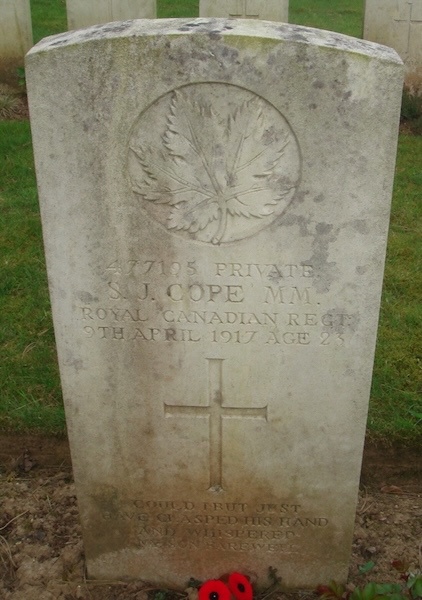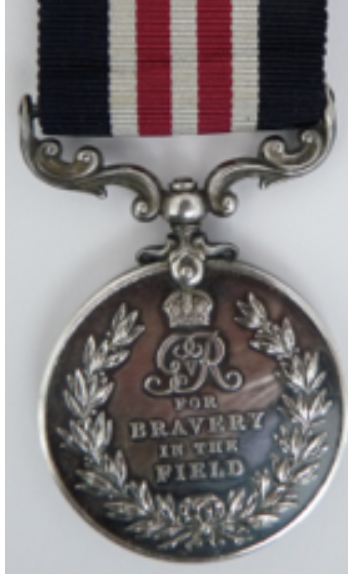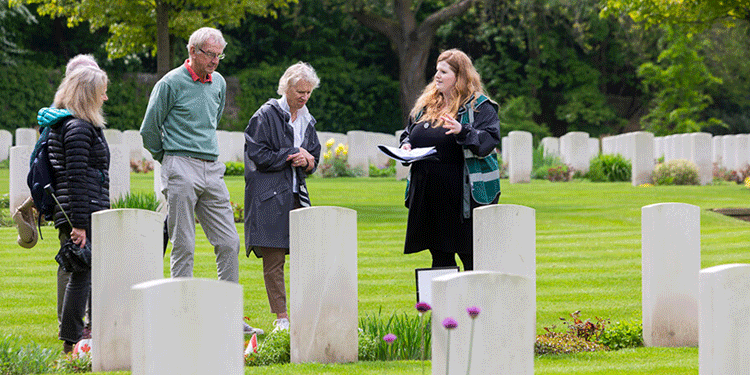
Sydney James Cope was the son of Frank Cope and Ellen Quick who had married on 1 January 1893 at the parish church in Rushden, Northamptonshire. Frank was a shoemaker, and the young couple began their married life on Newton Road, Rushden. A daughter named Minnie Louisa was born later that year.
By the following year the young family had moved about six miles to Raunds, where Sydney James was born on 28 September 1894. Sydney was taken for baptism to the parish church at Raunds on 7 October.
At some point in 1896 or 1897 the family moved to 17 North Street, Rushden, where they were still living when the 1901 census return was made. The family had grown significantly; there were seven children living at home, including Ellen’s son Ronald, who had been born in 1899, and whether or not Frank was his father, he was certainly brought up as Frank’s son. Sydney moved from the local infants’ school to Alfred Street school on 1 May 1901.
Times must have been difficult for the family. On 7 May 1902 Frank was admitted to the Northampton County Asylum, where he was an inmate for a year. This left Emma bringing up seven children alone, and presumably in a very precarious financial position. It seems that Sydney left Alfred Street school and attended Newton Road school for a while. It is possible that this was due to Emma having to move house.
On 7 May 1903 Frank suffered an accident; It was reported in the Northampton Mercury on 15 May 1903 that he had been placed into a padded room after the ‘recurrence of his fits of violence’ and had fallen whilst attempting a somersault. This apparently ruptured his spinal cord, and he died. A verdict of accidental death was recorded at the inquest.
At the beginning of the next school year Sydney and two of his sisters returned to Alfred Street school, their address was listed as 17 Little Street. Sydney left this school on 18 March 1904, returning briefly on 15 March 1905. It is unclear why Sydney left the school for a year, but with Ellen trying to support seven children it is quite possible that the children spent some time in children’s homes.
On 31 March 1905 the school admission register records that he was removed to London. Sydney was admitted to a children’s home, and on 22 June boarded the SS Southwark with a party of 161 other boys and 1 girl bound for Toronto. They landed at Quebec on 1 July.
Most of the children were travelling from Barnardo’s Homes, but five boys were crossed off this list as not belonging to Dr Barnardo's party. It is possible that Sydney was one of these boys, as his arrival form states that he was from Fegan’s Home, Stony Stratford.
In 1911 Sydney was living with the Raynard family in the Ashfield district of Huron West, Ontario, and working as a farm labourer. He later moved to 12 Wayland Avenue in East Toronto, where he worked for Nicholson & Co., Builders and Contractors, on Gerrard Street.
The Barnardo’s magazine, Ups & Downs, reported that Sydney made donations to the homes in 1914 and 1915.
On the outbreak of war Sydney initially presented himself for service in the army in August 1914. He had his medical examination on 14 August in Toronto, when he was recorded as being 5’ 7” tall, weighing 136 lbs. and being of good physical development. He was assigned to the Royal Canadian Regiment (RCR) with the service number 9838. After being stationed in Halifax briefly, Sydney arrived in Bermuda on 14 September 1914.
It appears from his service records that his only brush with authority during this time was when he was confined to barracks for 10 days for making a false statement to his commanding officer on 23 April 1915.
On 7 July 1915 he was examined and declared fit for service in the field, and on 22 August he attested to the Canadian Overseas Expeditionary Force, serving in the RCR with the new service number 477195. At this time he declared previous military service of 6 days. He was described as having a fair complexion, blue eyes and red hair, and stated his religion to be Church of England. His mother, Ellen was named as his next of kin, living in Dalton Parva, near Rotherham, Yorkshire.
It is not recorded in Sydney’s service records when he left Canada to sail to England, but we know that he was in England by 14 October 1915, when he made a will leaving all his personal possessions to his mother.
Sydney sailed to France as part of the same contingent as John Brookes, and served alongside him for the first few months that they were in France.
In April 1916 Sydney was granted 9 days leave, which must have been very welcome after a winter in the trenches. Unfortunately, he found himself in a less pleasant position the following month, when he was awarded 1 day Field Punishment No.1 for being absent from his post about 5.45am on 12 May.
In spring 1916 the RCR was involved trench line duty around the Mount Sorrel area, and was shelled heavily when German troops attacked the Canadian line on 2 June. This attack was repulsed, and the enemy beaten back after a second attack. Fighting continued and the regiment was relieved from the trenches on 6 June. The battalion that had relieved them was almost wiped out on the following day when four mines that had been under the RCR were blown.
Through the summer of 1916 the regiment remained in the area of the Somme, suffering heavy casualties in the attack on Regina Trench in September and in the Battle of the Ancre in October.
Sydney’s service notes that on 2 November 1916 he was awarded the Military Medal for bravery in the field. It is unclear on what date he earned the award, but it could well have been during the fighting in the battle of the Ancre. It is understood that the medal was in recognition of his bravery when rescuing a comrade under fire. The award was announced in the London Gazette supplement dated 6 January 1917.
Sydney would have experienced much the same preparations and training for the attack on Vimy Ridge as did John Brookes in the early days of 1917. Like John Brookes, it was on the first day of the attack, 9 April 1917, that Sydney lost his life. He was 22 year old. In total 80 men of the RCR died on that day, 48 of them are buried in La Chaudiere Military Cemetery.
Sydney’s death was reported in the Toronto Telegram the following month. A letter cited in the Toronto Star of 5 October 1917 reported that he ‘was instantly killed by a bullet through the head while dressing a comrade’s wounds.’
Saint Andrew’s parish newsletter of July 1917 also reported his death, illustrating the report with a quotation from a letter from another comrade: ‘My chum Pte S J Cope has met his death whilst in action... I went out to find him but was not successful. but I know that he was found and buried… A truer and braver soldier never entered France… I miss him as a brother. I wrote to inform his mother and received such a lovely letter - one which only mothers can write. It seems very strange that she should receive his medal which he was decorated with at the Somme on the day that he met his death.’
For his service to his country, in addition to the Military Medal, Sydney James Cope earned the 1914-1915 Star, the British War Medal and the Victory Medal. These were to be sent to Sydney’s mother, but it appears that the military authorities had some difficulty tracking her down; the medals were returned three times in all - the first time the package was marked ‘gone away’, the second time there was insufficient address.
Sydney was originally buried in a grave marked with a Graves Registration Unit cross; there were no personal effects found at the site. He was reburied at La Chaudiere Military Cemetery on 18 August 1919.
His mother, Ellen, by then living at Pywipe, Grimsby, paid for the inscription on his headstone, at a cost of 16/4d: ‘Could I but just have clasped his hand and whispered my son farewell.’
Sydney’s service record shows that assigned pay to be made to Ellen was set at 2nd Lieutenant rate.
Sydney’s younger sister Jessie May was also a British Home Child, travelling in February 1911 aboard SS Sicilian with a party of children from Barnardo’s Homes. His youngest sister Ruby stayed in England and in 1939 was living near Grimsby. Arthur, the youngest sibling joined the Royal Navy after the war. Both Ruby and Arthur died in the Grimsby area.


